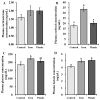How do crate materials impact the winter transport of broilers?
- PMID: 39483003
- PMCID: PMC11917388
- DOI: 10.5713/ab.24.0344
How do crate materials impact the winter transport of broilers?
Abstract
Objective: Pre-slaughter transportation adversely impacts the welfare, meat yield, and quality of broilers, yet the effects of different crate types on broiler chickens during winter remain underexplored. The goal of this study was to investigate the effect of plastic and iron crates in transit on meat quality, carcass, and physiological traits of broiler chickens during winter.
Methods: A total of 175 (35-day-old) Ross 308 male broilers with an average body weight of about 1,708±33.3 g (mean±standard error of the mean) were picked after 4 hours of feed withdrawal before transport. The control group comprises birds in the farm (n = 15) without transportation at 173 cm2/kg density. The birds were transported into fixed iron (25 birds per crate) and plastic crates (15 birds per crate) with four replicates per crate type at the same 173 cm2/kg densities. The transportation distance was 20 km for 40 min at an average speed of 30-50 km/h early morning at 8:00 am under -1°C and 47% relative humidity.
Results: There was no difference (p>0.05) in carcass traits among the treatments. Concerning meat quality, broilers transported in both crate types exhibited lower (p<0.01) a* values compared to the control group. Additionally, the iron crate group demonstrated higher (p<0.05) b* values for the breast meat compared to the other groups. In terms of blood metabolites, the iron crate group had higher (p<0.05) cortisol, glucose, and lactate levels compared to the control group that did not transport.
Conclusion: Broilers transported in the iron crates increase stress levels in terms of higher cortisol, glucose, and lactate contents in the blood plasma compared to untransported broilers during the winter. Therefore, employing plastic crates, which induce significantly reduced cortisol and numerically lower glucose levels compared to iron crates, appears more favorable for animal welfare by mitigating stress.
Keywords: Animal Welfare; Broilers; Crate; Meat Quality; Stress; Transportation.
Conflict of interest statement
No potential conflict of interest relevant to this article was reported.
Figures

Similar articles
-
Effect of different crate material types for transit on production, physiological characteristics, and welfare of broilers during the summer season.J Anim Sci Technol. 2024 Nov;66(6):1193-1202. doi: 10.5187/jast.2024.e48. Epub 2024 Nov 30. J Anim Sci Technol. 2024. PMID: 39691616 Free PMC article.
-
Meat Quality and Cooking Characteristics in Broilers Influenced by Winter Transportation Distance and Crate Density.J Poult Sci. 2020 Apr 25;57(2):175-182. doi: 10.2141/jpsa.0190014. J Poult Sci. 2020. PMID: 32461733 Free PMC article.
-
Influence of Long-Distance Transportation Under Various Crating Densities on Broiler Meat Quality During Hot and Humid Weather.J Poult Sci. 2020 Jul 25;57(3):246-252. doi: 10.2141/jpsa.0190087. J Poult Sci. 2020. PMID: 32733160 Free PMC article.
-
Effects of crating and transport on stress and meat quality characteristics in broilers.Poult Sci. 1997 Mar;76(3):523-9. doi: 10.1093/ps/76.3.523. Poult Sci. 1997. PMID: 9068055
-
Dietary resveratrol supplementation prevents transport-stress-impaired meat quality of broilers through maintaining muscle energy metabolism and antioxidant status.Poult Sci. 2017 Jul 1;96(7):2219-2225. doi: 10.3382/ps/pex004. Poult Sci. 2017. PMID: 28339929 Free PMC article.
References
Grants and funding
LinkOut - more resources
Full Text Sources

